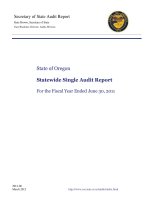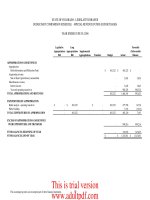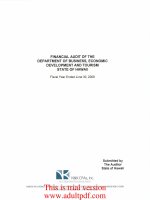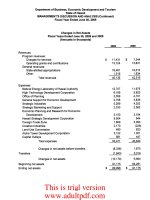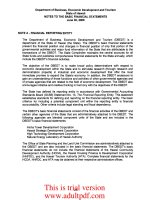Department of Education State of Hawaii SCHEDULE OF EXPENDITURES OF FEDERAL AWARDS (Continued) Fiscal Year Ended June 30, 2005_part6 doc
Bạn đang xem bản rút gọn của tài liệu. Xem và tải ngay bản đầy đủ của tài liệu tại đây (321.77 KB, 10 trang )
NISHIHAMA
&
KISHIDA,
CPA's,
INC.
CERTIFIED
PUBLIC
ACCOUNTANTS
Internal Control Over Compliance
The management
of
the DOE
is
responsible for establishing and maintaining effective
internal control over compliance with the requirements
of
laws, regulations, contracts
and grants applicable to federal programs.
In
planning and performing our audit, we
considered the DOE's internal control over compliance with requirements that could
have a direct and material effect
on
a major federal program
in
order to determine our
auditing procedures for the purpose of expressing our opinion
on
compliance and to test
and report on internal control over compliance
in
accordance with OMS Circular A-133.
We noted certain matters involving the internal control over compliance
and
its
operation that we consider to
be
reportable conditions. Reportable conditions involve
matters coming to our attention relating to significant deficiencies
in
the design
or
operation of the internal control over compliance that,
in
our judgment, could adversely
affect the DOE's ability to administer a major federal program
in
accordance with the
applicable requirements of laws, regulations, contracts and grants. Reportable
conditions are described
in
the accompanying schedule of findings and questioned
costs as items 2005-04 to 2005-05.
A material weakness
is
a reportable condition
in
which the design or operation of one or
more
of
the internal control components does not reduce to a relatively low level the risk
that noncompliance with the applicable requirements of laws, regulations, contracts and
grants caused by error or fraud that would
be
material
in
relation to a major federal
program being audited may occur and not
be
detected within a timely period by
employees
in
the normal course of performing their assigned functions. Our
consideration of the internal control over compliance would not necessarily disclose all
matters
in
the internal control that might
be
reportable conditions and, accordingly,
would not necessarily disclose all reportable conditions that are also considered to
be
material weaknesses. However, we believe that none of the reportable conditions
described above
is
a material weakness. We also noted other matters involving the
internal control over compliance that we have reported to the management
of
the DOE
in
a separate letter dated February 28, 2006.
This report
is
intended solely for the information and use of management, federal
awarding agencies and pass-through entities and
is
not intended to
be
and should not
be used by anyone other than these specified parties.
Honolulu, Hawaii
February 28, 2006
51
This is trial version
www.adultpdf.com
PART IV
SCHEDULE OF FINDINGS AND QUESTIONED COSTS
52
This is trial version
www.adultpdf.com
Department
of
Education
SCHEDULE OF FINDINGS AND QUESTIONED COSTS
Fiscal Year Ended June 30, 2005
SECTION I - SUMMARY OF AUDITORS' RESULTS
Financial Statements
Type
of
auditors' report issued:
Internal control over financial reporting:
Material weakness(es) identified?
Reportable condition(s) identified
not considered to be material weaknesses?
Noncompliance material to the financial statements
noted?
Federal Awards
Unqualified
_yes
~no
~
yes _ none reported
_yes
~no
Food Donation
Name
of
Federal Program
Internal control over major program:
Material weakness(es) identified?
Reportable condition(s) identified
not considered to be material weaknesses?
Type
of
auditors' report issued on compliance
for
major programs:
Any
audit findings disclosed that are required to be
reported
in
accordance with OMB Circular A-133,
Section .510(a)?
Identification
of
major programs:
CFDA Number
10.550
_yes
~yes
Unqualified
~yes
~no
_ none reported
no
10.553
10.555
10.556
10.559
10.558
84.041
84.298
84.318
84.357
84.367
Child Nutrition Cluster:
School Breakfast Program
National School Lunch Program
Special Milk Program for Children
Summer Food Service Program
for Children
Child and Adult Care Food Program
Impact Aid
State Grants for Innovative Programs
Education Technology State Grants
Reading First State Grants
Improving Teacher Quality State Grants
Dollar threshold used to distinguish between Type A
and Type B programs:
Auditee qualified as a low-risk auditee?
53
$3,000,000
_yes
~no
This is trial version
www.adultpdf.com
Department
of
Education
SCHEDULE OF FINDINGS AND QUESTIONED COSTS
(Continued)
Fiscal
Year
Ended
June
30, 2005
SECTION
11-
FINANCIAL STATEMENT FINDINGS
Ref
No. Internal Control Findings
2005
-
01
Improve Compensating Controls
For
Inadequate Segregation
Of
Duties
over
Local
School Funds
Most, if not all, of a school's cash functions are handled by a school's school
administrative services assistant (SASA) or account clerk. One person receives the
cash, prepares the receipts for deposit to the bank, prepares the checks, records the
receipts and disbursements, and prepares the bank reconciliation.
No
one person should have access to both physical assets and the related accounting
records, or to handle all phases
of
a transaction. Without adequate segregation
of
duties, funds may
be
lost, unrecorded or misused.
For many schools, it is not possible to delegate the duties to another person. To
compensate for inadequate segregation of duties, the DOE established control
procedures that are to
be
performed by the school principal or designee. The control
procedures are enumerated
in
Exhibit 9-12 of the FMS User Policy and Process Flow
Guide (Guide) as well as
on
the DOE's website.
We visited ten schools during our test
of
the nonappropriated local school funds and
noted the following conditions:
• Seven schools
had
inadequate segregation of duties but did not perform all the
compensating controls enumerated
in
the Guide. The schools did not conduct
unannounced cash counts of the school petty cash fund or check if cash receipts
were deposited daily. Two
of
the schools did not review bank reconciliations
in
a
timely manner.
• Three schools performed all the compensating controls and used the
administrator's checklist that was available
on
the DOE's website to document their
performance
of
the compensating controls. However, the checklist alone did not
provide sufficient information
on
whether any discrepancies were found.
Exhibit 9-12 of the Guide provides the following compensating controls:
1.
Conduct periodic unannounced cash counts of the school petty cash fund.
2.
Verify that monthly reconciliations between the bank statement and the school's
check register are being performed.
54
This is trial version
www.adultpdf.com
Department of Education
SCHEDULE OF FINDINGS AND QUESTIONED COSTS (Continued)
Fiscal Year Ended June 30, 2005
Ref
No.
Internal Control Findings (Continued)
2005
•
01
Improve Compensating Controls For Inadequate Segregation Of Duties over Local
School
Funds
3.
Inspect checks outstanding for more than six months ("stale" checks) during the
review of the monthly bank reconciliations. These checks should
be
cancelled.
4.
Check if cash receipts are deposited daily. The dates
on
the Official Receipts Form
239 should
be
the same
as
the bank deposit slip date.
5.
The principal or designee will prepare a report of the reviews conducted during the
year indicating the areas reviewed, the date of the reviews, discrepancies found
and the report should
be
kept
on
file for audit purposes.
Recommendation
The school principal or designee should perform all compensating controls enumerated
in
Exhibit 9-12
of
the Guide, including documentation of the procedures performed and
the results.
In
addition, appropriate action should
be
taken and documented for any
discrepancies noted.
55
This is trial version
www.adultpdf.com
Department
of
Education
SCHEDULE OF FINDINGS AND QUESTIONED COSTS (Continued)
Fiscal Year Ended June 30, 2005
Ref
No. Internal Control Findings (Continued)
2005
-
02
Strengthen Controls Over Workers' Compensation Data
Workers' compensation payment data, estimated and actual, are maintained using the
Renaissance (REN) software program and are used for multiple purposes. However, the
DOE cannot
be
assured
of
the completeness
and
accuracy of wage loss payments.
In
addition reserves
on
open claims
had
negative balances
as
of
June
30,
2005.
In
prior years, due to software licensing issues and incompatibility with the DOE's payroll
system, paid wage loss information was maintained separately from
REN
which resulted
in
inefficiencies and inaccuracies
in
financial reporting. The DOE has implemented
different procedures to improve their workers' compensation information system.
Effective October
1,
2004, the Workers' Compensation office maintained
an
electronic
spreadsheet of claims filed and paid
in
order to track unpaid claims. Maintaining the
spreadsheet was time-consuming. We were informed that tracking unpaid claims could
not
be
done using
REN
because
REN
did not allow the input of estimated wage loss
payments.
In
August 2005, the
DOE
upgraded
REN
which enabled the DOE to record
estimated and actual wage loss payments which allowed DOE to track unpaid claims
more efficiently. However actual payments recorded
in
REN
were not reconciled to
payments recorded
in
the DOE's payroll system to ensure completeness and accuracy.
Finally,
we
noted numerous open claims
as
of
June
30,
2005, with negative reserve
balances that totaled over $4 million. Reserves were not adjusted when actual payments
exceeded the initial reserve amount for the claim.
The
DOE
needs complete and accurate wage loss payments recorded in
REN
to
properly identify unpaid wage loss claims that may result
in
late payment penalties,
identify potential incorrect payments, and to provide historical payments that
can
be
used to evaluate a component of workers compensation liability for financial statement
reporting. Reserves
on
open claims represent estimates of payment amounts to settle
claims which should
be
periodically readjusted
and
should not have negative balances.
56
This is trial version
www.adultpdf.com
Department
of
Education
SCHEDULE OF FINDINGS AND QUESTIONED COSTS (Continued)
Fiscal Year Ended
June
30, 2005
Ref
No. Internal Control Findings (Continued)
2005
-
02
Strengthen Controls Over Workers' Compensation Data
Recommendation
The DOE should strengthen its controls over workers' compensation data maintained
in
REN
by performing the following:
1.
Reconcile the wage loss payments recorded
in
REN
to the payments recorded
in
the payroll system to ensure completeness and accuracy of both the wage
loss data recorded
in
REN
and payments made by the Payroll Section. The
Workers Compensation Office and the Payroll Section should investigate
discrepancies between their records and make necessary corrections for any
recording or payment errors.
2.
Periodically re-evaluate and adjust reserve balances, particularly balances that
are at risk of becoming negative, to ensure reasonableness of reserve amount.
57
This is trial version
www.adultpdf.com
Department
of
Education
SCHEDULE OF FINDINGS AND QUESTIONED COSTS (Continued)
Fiscal Year Ended
June
30, 2005
Ref
No. Internal
Control
Findings
(Continued)
2005
• 03
Improve
Monitoring
System
for
Vacation and
Sick
Leave Records
The DOE uses a computerized leave accounting system to compile and print accrued
compensated absences information for reporting the liability to the State Comptroller. All
leave taken are transmitted from the TSEA (electronic substitute teacher system) for
teachers or recorded
in
the computerized leave accounting system by the DOE's Payroll
Section for all other employees. A manual form is submitted to the Payroll Section for
recording leave taken in instances when TSEA
is
not used.
The official record for compensated absences is the
Employee Leave Record (Form 7),
which
is
separately maintained electronically or manually by the various schools and
offices. All leave taken recorded
in
the computerized leave accounting system and Form
7 is supported by the approved
Application for Leave
of
Absence, Forms G-1, 400 or
400A, which documents the request and approval
of
absences.
During our testing
of
accrued vacation and sick leave records for eight employees, we
noted the following conditions:
•
In
7 instances, the vacation and sick leave balances calculated using the
computerized leave accounting system as of June
30,
2005, did not agree to Form
7.
•
In
2 instances, leave recorded on the Form 7 was not supported by an Application
for Leave
of
Absence.
•
In
2 instances, the Application for Leave
of
Absence was not dated or dated after
the leave was taken.
•
In
2 instances, the signed Application for Leave
of
Absence did not indicate
whether the leave was approved or denied.
In
addition, we noted 5 instances
in
which the computerized leave accounting system
included vacation balances for terminated employees. We were informed that not all
leave taken may have been recorded
in
the computerized leave accounting system
because the schools did not submit copies
of
the Application for Leave
of
Absence
in
a
timely manner to the Payroll Section. Similarly, termination documents were not
submitted to the Payroll Section
in
a timely manner.
Recommendation
The DOE should improve its monitoring system to ensure that the schools prepare leave
documents completely and accurately, and submit the necessary leave documents to
the Payroll Section
in
a timely manner.
58
This is trial version
www.adultpdf.com
Department
of
Education
SCHEDULE OF FINDINGS AND QUESTIONED COSTS (Continued)
Fiscal Year Ended June 30, 2005
SECTION
III
• FEDERAL AWARD FINDINGS
Ref
No.
Compliance and Internal Control Findings
2005
• 04 Ensure Accurate Meal Counts Are Obtained for the School Lunch
And Breakfast Programs.
7 CFR 210 provides meal reimbursement requirements for the National
School Lunch Program (CFDA 10.555)
and
School Breakfast Program
(CFDA 10.553). To
be
eligible for federal reimbursement, meals must
be
served to eligible children and must
be
supported by accurate meal
counts and records indicating the number of meals served by category
and type. The DOE's policies and procedures over this requirement are
communicated to the schools
in
its Standards and Procedures for Free
and Reduced Price Meals which require School Food Service managers
to prepare and sign the daily and monthly "Computation
of
Daily/Monthly
School Food Service Transactions," Form SL-5, reports.
These daily and monthly Form SL-5 are used to compile monthly lunch
counts that are submitted for reimbursements by the federal award
agency.
During our testing of the National School Lunch and School Breakfast
Programs,
we
noted the following:
• Three instances where the amounts reported
on
daily Form SL-5 did
not agree to the supporting documents.
• One instance where amounts per the validated deposit slip did not
agree to the daily SL-5.
$
Recommendation
The
DOE
should ensure that the daily and monthly Form SL-5
be
properly
completed and supported by the schools to ensure
an
accurate claim for
reimbursement
is
made.
59
Questioned
Costs
This is trial version
www.adultpdf.com
Department
of
Education
SCHEDULE
OF
FINDINGS AND QUESTIONED COSTS (Continued)
Fiscal Year Ended
June
30, 2005
Ref
No. Compliance and Internal Control Findings (Continued)
2005
- 05 Ensure Annual Verification Procedures are Completed Timely and
Accurately
7 CFR 245.6a requires that
by
December
15
of each school year, the
School Food Authority shall have selected and verified a sample of their
approved free and reduced price applications
in
accordance with federal
regulations for the National School Lunch Program (CFDA 10.555) and
the School Breakfast Program (CFDA 10.553). The
DOE
communicates
this requirement and the procedures
on
completing the verification
process to the schools
in
their "Verification Guidance" manual that the
School Food Services Branch distributes.
During our testing
of
this verification process, we noted the following:
• Two schools reported counts
on
the "Report on Verification
of
Free
and Reduced-Price Meal Application" that did not agree to the actual
verification results.
• Three schools completed and submitted the "Report
on
Verification of
Free and Reduced-Price Meal Application" late.
Questioned
Costs
• Two schools discarded the "Report
on
Verification
of
Free and
Reduced-Price Meal Application."
As
a result, the report was not
available for our review.
$
Recommendation
Schools should follow the Verification Guidance provided and submit the
reports
in
a timely manner. They should also review their "Report
on
Verification of Free and Reduced-Price Meal Application" prior to
submission to ensure accuracy of the report.
60
This is trial version
www.adultpdf.com
